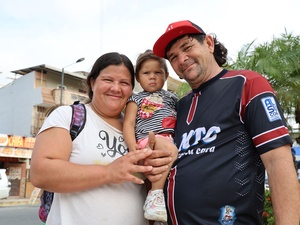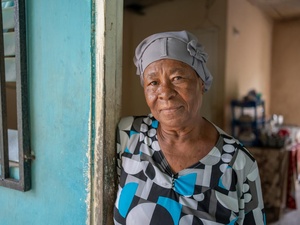La India: an oasis of peace in the midst of the Colombian conflict
La India: an oasis of peace in the midst of the Colombian conflict

Luis Carlos Renteria and another member of La India's association of displaced people next to the monument for a community leader murdered by an irregular armed group.
LA INDIA, Colombia, April 17 (UNHCR) - When Hugo had to flee his home in the Colombian department of Santander last month, he did not have to think twice to know where to go. A few hours down the Carare River, the small community of La India has gained a reputation over the years as a safe haven from the violence of the Colombian conflict. Within hours, he and his family had put their few belongings on a small boat and were making their way downstream.
"When people come to La India, they immediately start feeling safe. We never turn anyone away who needs a refuge," said Luis Carlos Renteria, president of the local association for displaced people. "When big groups arrive, they stay in the school's building for a while. When it is just one or two families, we find room for them in one of our homes."
Like many of the community's 5,000 inhabitants, Luis Carlos himself arrived to La India after being forced to flee the violence further upriver. This was five years ago, and today Luis Carlos divides his time between teaching displaced children and his work for the association. With the help of UNHCR, he's lobbied the municipal authorities in the town of Landázuri - more than two hours away on a dirt road that floods every time it rains - to donate 37 hectares of land on which the displaced people themselves are building houses for 48 families.
"The idea is that they will have enough land to grow food for themselves and also to sell," Luis Carlos explains. "The biggest problem here for displaced families is the lack of economic opportunities. This is a blessed region: everything grows, bananas, corn, cocoa, and it's easy to send everything downriver to the buyers - but first, people need land."
The history of La India has always been one of people trying to make the best of their lives in the face of adversity and often tragedy. Some fifty years ago a small group of Afro-Colombians, who had left the Pacific Coast to find a better life in the north-eastern department of Santander, built a few houses of clay and straw along the banks of the Carare River. It did not take long before the small community, which became known as La India, got caught up in violence.
From the very start of the conflict that has plagued Colombia since the mid-1960s, irregular armed groups have been heavily present and active in the Santander region. Between 1973 and 1987, more than 500 people were killed in La India while thousands of people along the Carare River were forced to leave their homes. Finally, the armed groups gave the community an ultimatum: join one side or the other; leave the region, or die.
The people of La India chose another option: to organise peacefully in order to remain on their land. The association of peasant workers of the Carare region (ATCC for its Spanish acronym) was born. Its goal was simple: to adhere to the principles of non-violence and dialogue at all time with the aim of setting up an oasis of peace in the midst of the conflict.
But the path of non-violence was never easy. As La India's reputation as a peace community grew, so did the antagonism of some of the groups. On one day in February 1990, four ATCC leaders were murdered by members of an irregular armed group. A journalist who was filming a documentary in La India on that day was also killed. A few months after that terrible day, La India received the Nobel Peace Alternative prize. Five years later, it was one of 50 communities around the world to receive a United Nations Community Award on the occasion of the UN's fiftieth anniversary.
"The support of international organisations like UNHCR has been absolutely crucial," Luis Carlos says. "It has helped us to get the attention of the state, which we did not have before. Now they are sending us teachers, even doctors. That's very important, because what matters most now is for people to regain faith in the institutions of the state. It will take time to build that trust."
The same situation is true, he says, for many other communities in the area. Over the past few years, UNHCR has helped create a network of associations of displaced people in the region, with the aim of strengthening the power of such organisations to represent their members at the local and national level.
Around La India, the situation remains tense. Only last year, armed groups imposed a blockade on the river, completely cutting off a community further upriver for weeks. In October, Luis Carlos, along with UNHCR staff and representatives from the local church, was on the boat that broke the blockade and brought food to the beleaguered community.
But for all the difficulties and the persistent danger, La India has become home to hundreds of displaced families who never want to have to leave again. "I came to Santander from Chocó 18 years ago," Luis Carlos says. "Five years ago, I moved to La India. There is no going back for me. I am a citizen of this country, and this is my home now."
By Marie-Hélène Verney in La India, Colombia









